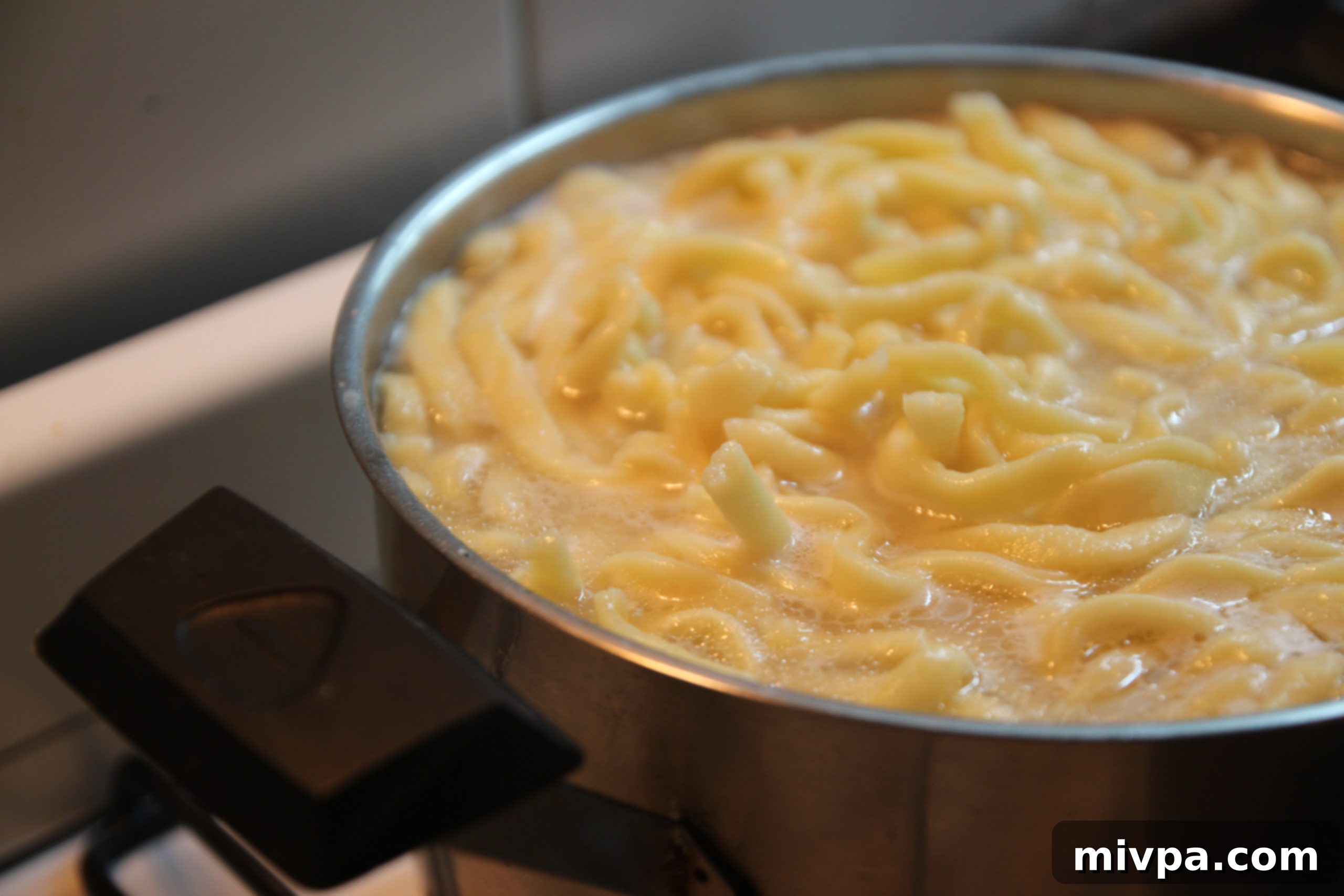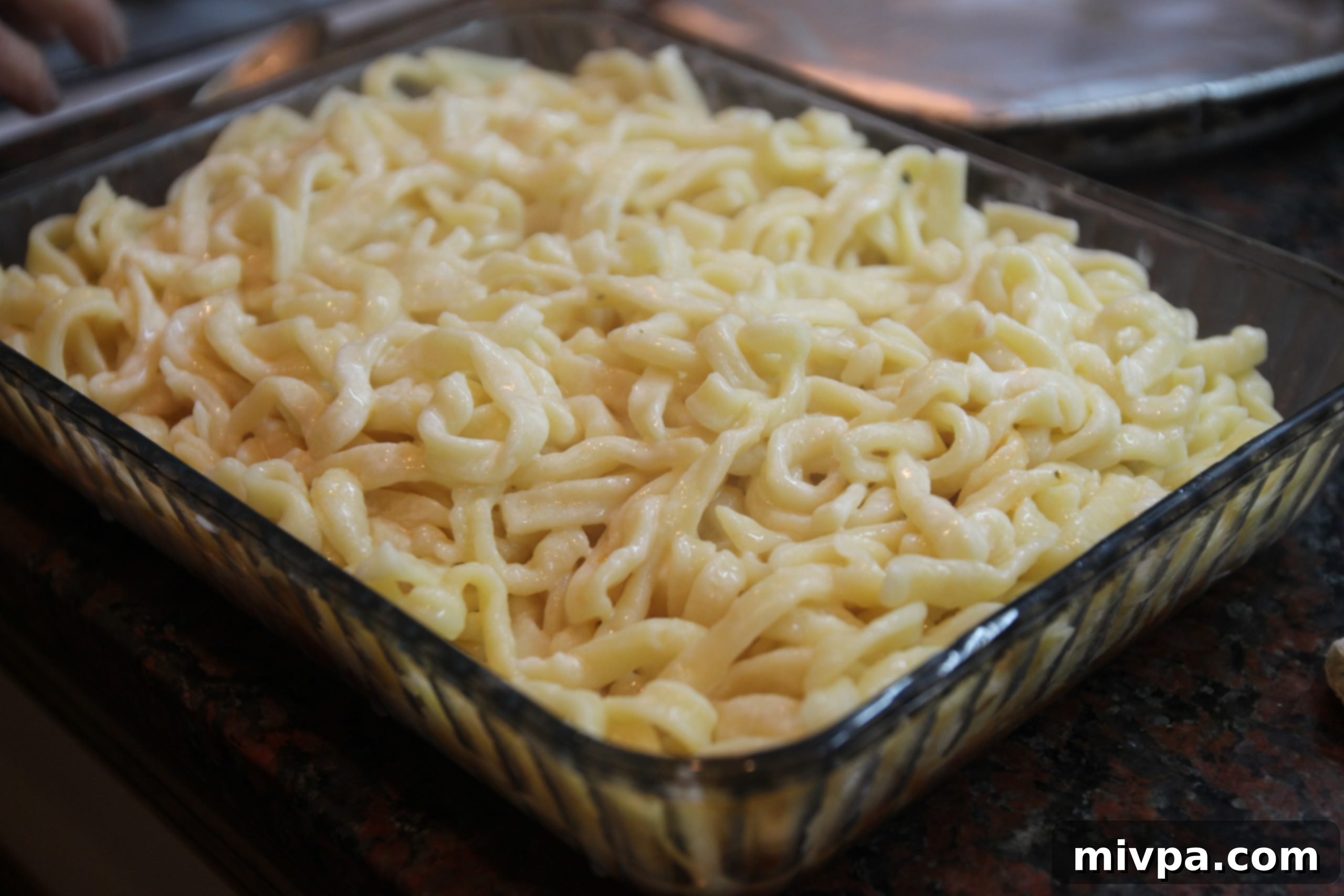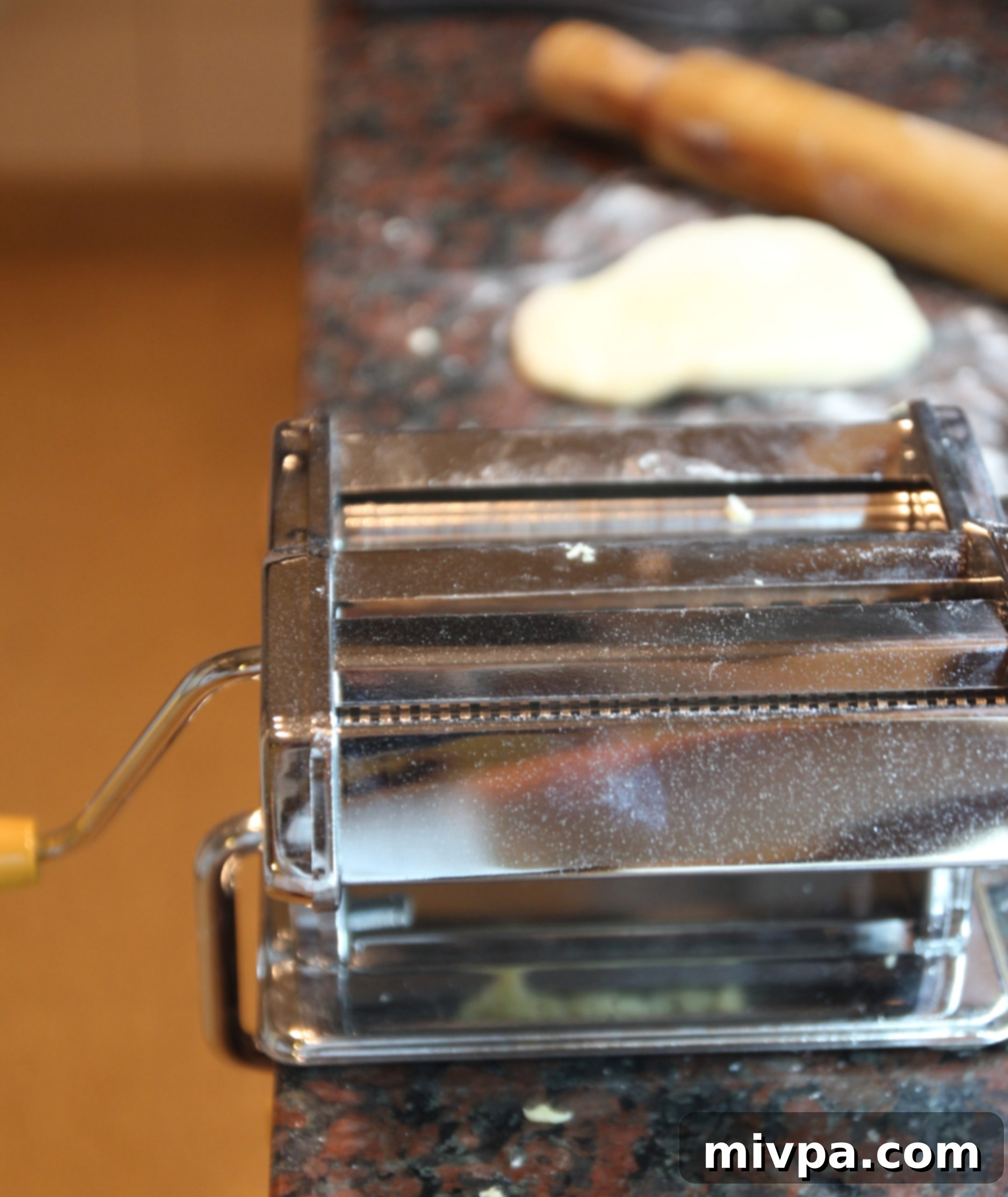The Journey to Homemade Tagliatelle: My First Fresh Pasta Adventure
The culinary world often presents us with daunting challenges, and for me, one such Everest was the idea of making pasta from scratch. Last Wednesday evening found me in my kitchen, a scene of furrowed brows and puzzled expressions. Before me lay a pasta-making machine, its various dials and rollers seemingly simple, yet its true operation felt shrouded in mystery. Was it genuinely as straightforward as it appeared, or was this an elaborate trap designed to ensnare amateur home cooks?
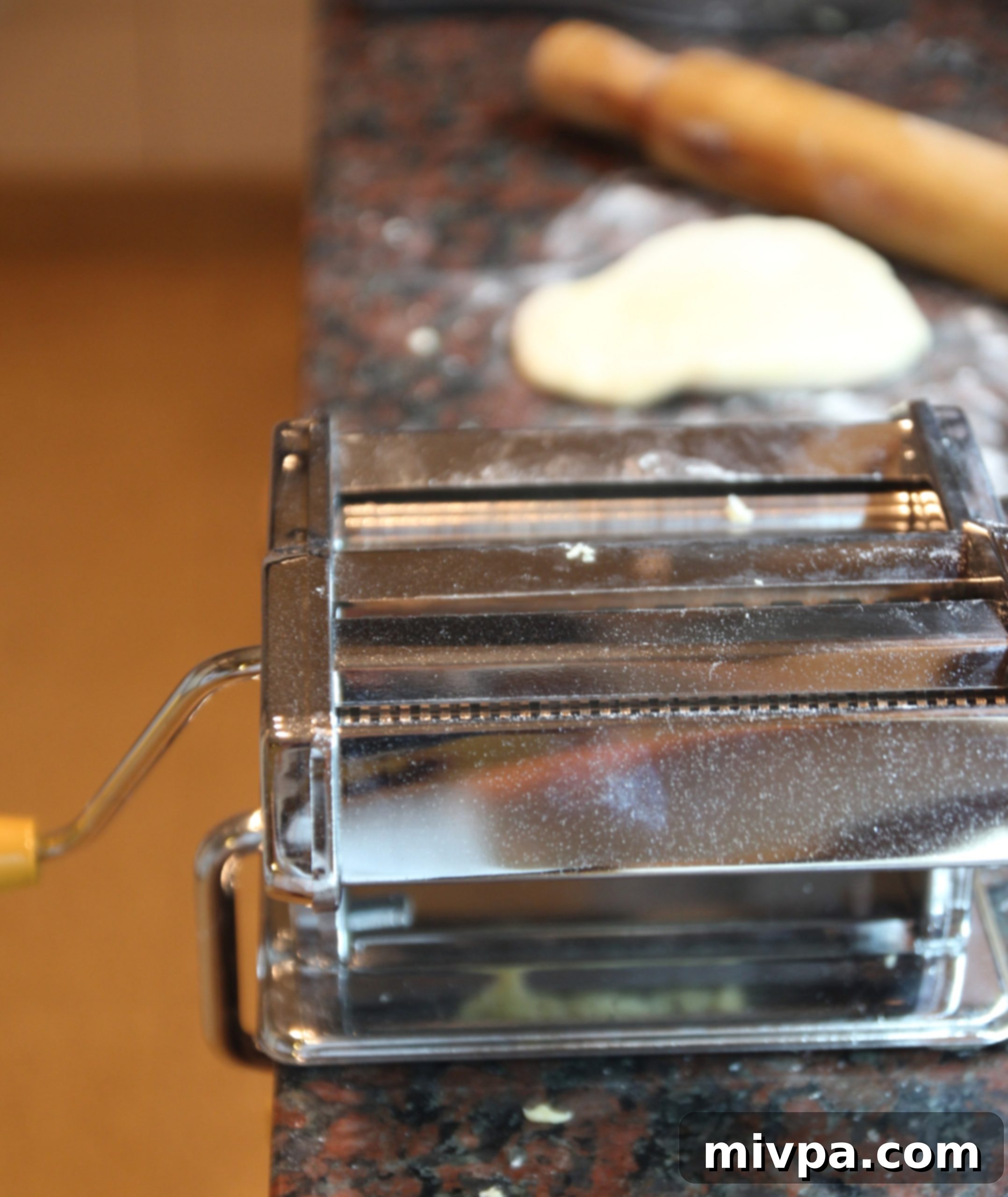
For over a year, I had been locked in a mental tug-of-war with the concept of crafting fresh pasta. The romantic notion of emulating an Italian Nonna, creating silky strands of dough that far surpassed the pre-packaged dried varieties, was incredibly alluring. Yet, the reality of attempting it would consistently send a shiver down my spine, a cold sweat breaking out at the mere thought of failure. It was a dream I admired from a distance, a culinary feat I deeply desired but feared to undertake.
The Irresistible Allure of Freshly Made Pasta
My fascination with homemade pasta began the first time I tasted truly fresh pasta in Argentina. The experience was transformative, unlike anything I had ever encountered from a box. This moment ignited a passion, much like how I’d fallen in love with other artisanal kitchen crafts: the comforting aroma of homemade bread, the vibrant sweetness of fresh jams, or the flaky perfection of hand-made pie-crusts. There’s an undeniable magic in taking the simplest ingredients – flour, eggs, water – and transforming them into something extraordinary through effort and love.
The idea of combining these humble components, kneading the dough until it achieves a perfect, homogeneous consistency, and then watching it emerge from the pasta maker in delicate, soft ribbons, light and cool to the touch, grew more enchanting with each passing day. It spoke to a deeper connection with food, a return to basics that felt profoundly satisfying.
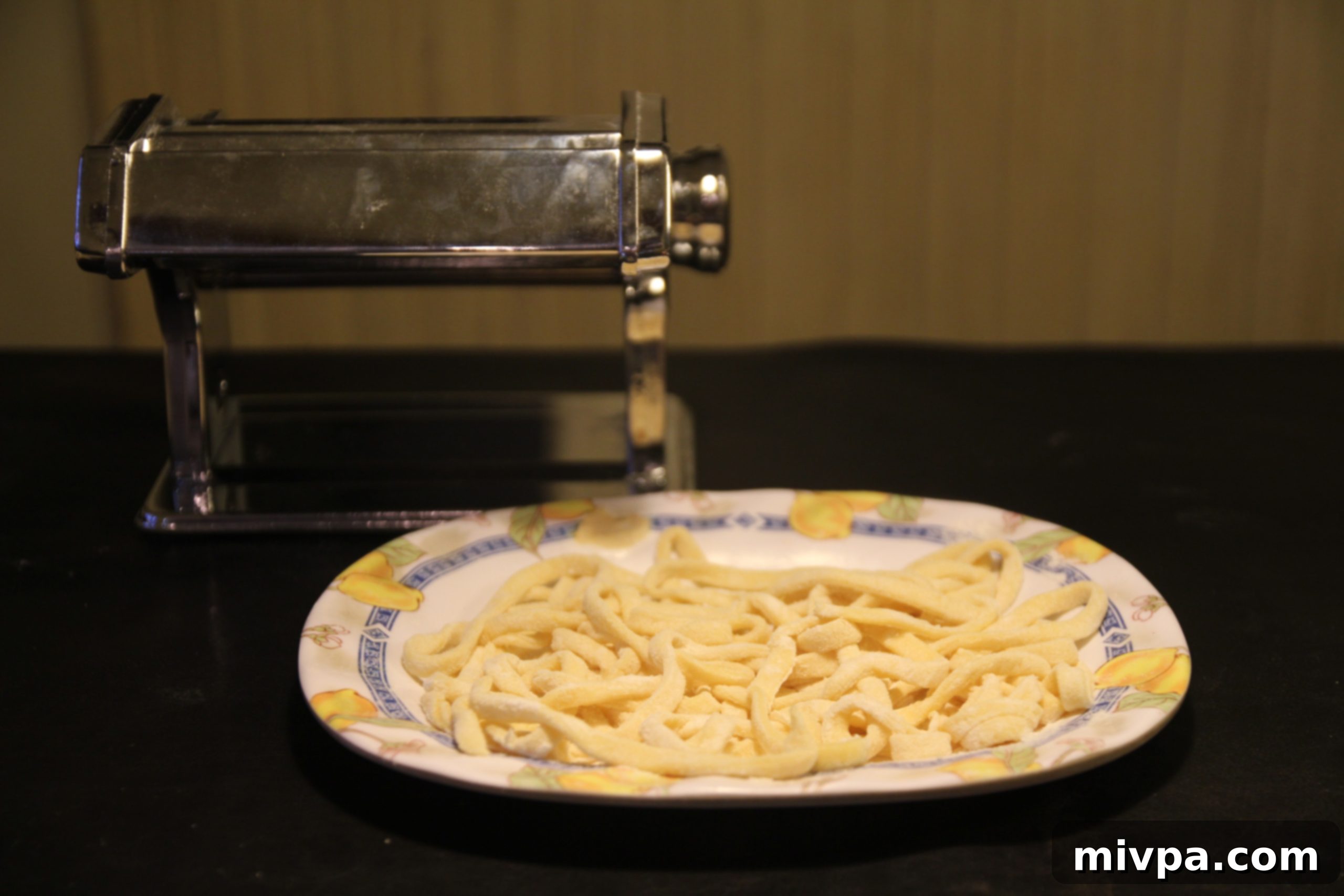
Why Tagliatelle Captured My Heart
Among the myriad of pasta shapes, tagliatelle has always held a special place in my heart. These long, flat, golden ribbons, originating from the Italian regions of Emilia-Romagna and Marches, possess a rustic elegance. What makes fresh tagliatelle particularly delightful is its porous and slightly rough texture. Unlike its dried counterpart, this fresh surface allows sauces and ingredients to cling beautifully, ensuring every bite is a harmonious blend of flavors and textures. It’s designed to embrace rich, hearty sauces, making for an incredibly pleasurable dining experience.
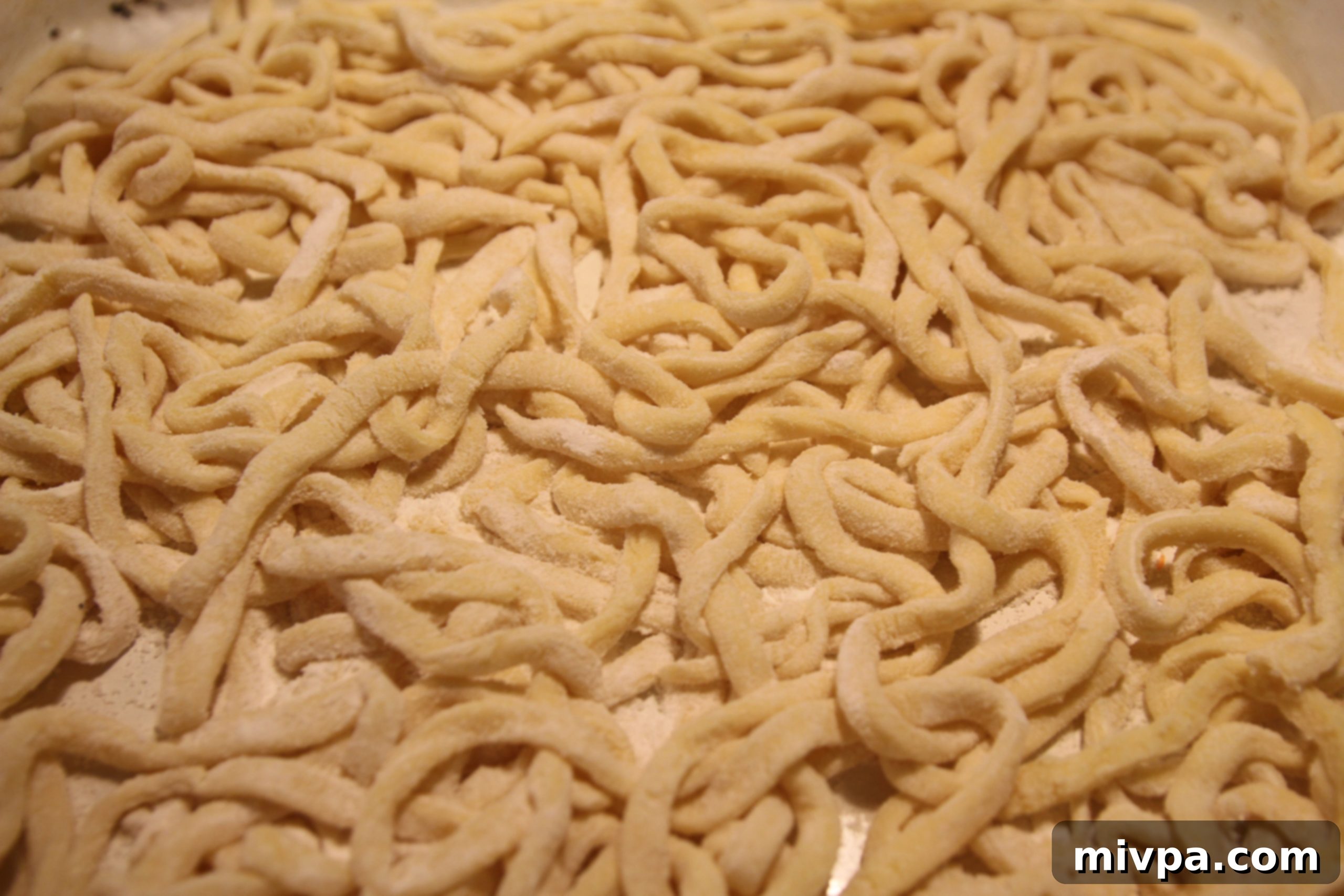
Despite this long-harbored desire, the sheer notion of pasta making felt like an insurmountable task. The perceived complexity, the fear of investing hours only to end up with an inedible mess, kept me firmly planted in my comfort zone. “I’m not Italian,” I’d often remind myself. “I grew up eating rice, not pasta. What makes me think I could succeed?” This internal dialogue was a powerful deterrent, fostering a longing that wasn’t quite strong enough to overcome the apprehension.
An Unexpected Inspiration: The Argentine Countryside
Life, however, has a funny way of presenting opportunities when you least expect them. In an unpredictable turn of events, my partner Juan and I found ourselves taking a short break, immersing ourselves in the tranquil beauty of the Argentine countryside. It was during our stay at the charming ranch “La Rica” that my pasta-making dilemma resurfaced with renewed urgency.
At La Rica, we were incredibly fortunate to be looked after by Claudia, a woman who seemed to effortlessly manage every aspect of the household. More than just a housekeeper, Claudia was an absolutely phenomenal cook. She delighted us with generous portions of homemade cakes, crispy fried doughnuts, intriguing local dishes, and, to my immense pleasure, an abundance of fresh, homemade pasta.
Each strand of Claudia’s pasta was a revelation. Its tender chewiness, its ability to absorb and enhance the accompanying sauces, was simply divine. With every delicious mouthful, my long-dormant desire to make my own pasta intensified. After copious comments to Juan about the pasta’s perfection and his enthusiastic agreement, I finally gathered the courage to ask Claudia for her secret recipe. To my relief, she was not one of those cooks who guard their recipes jealously. Without much prompting, she rattled off the ingredients and steps with ease, a testament to years of practice and deep familiarity. I hastily scribbled everything into my phone, terrified of forgetting a single detail.
From Procrastination to Passion: The First Attempt
The recipe then sat, incubating in my phone for a couple of weeks. My old friend, procrastination, returned with a convenient excuse: “I don’t own a pasta maker.” This allowed me to push the task further down my mental to-do list. However, my excuses ran dry when Juan and I stumbled upon a fantastic deal on a pasta maker at a mega department store just last weekend. It was an opportune moment, a sign from the culinary gods. I knew it was time. (Of course, I understood that Claudia’s recipe might not be the most “authentic” Italian pasta recipe, but it was certainly worth a shot, a valuable starting point for my journey.)
So there I was, in my kitchen on that Wednesday night, the pasta maker gleaming expectantly on the counter. My fingers and toes were crossed, hoping I could do Claudia’s simple yet profound recipe justice. The initial trepidation was palpable, but as I began to gather the ingredients – light, airy flour, rich whole eggs, and just the right amount of water – a remarkable shift occurred. My fears began to evaporate, replaced by a growing sense of excitement and focus.
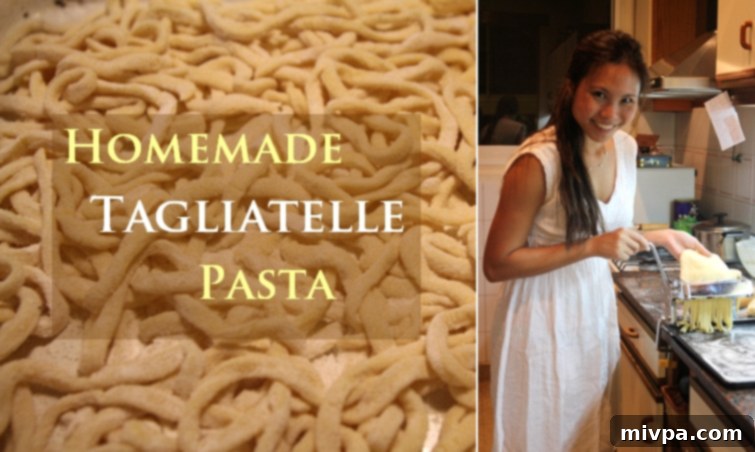
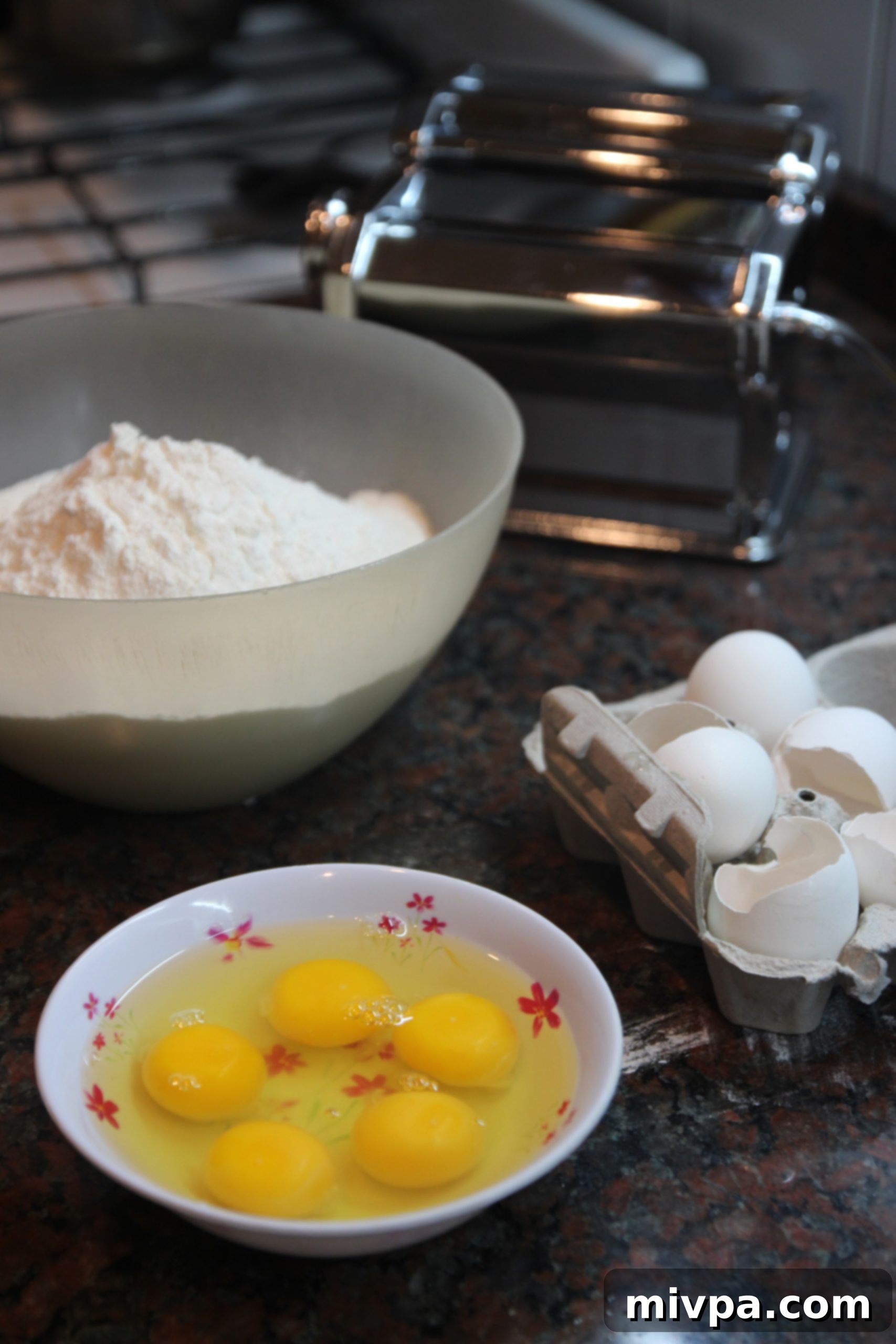
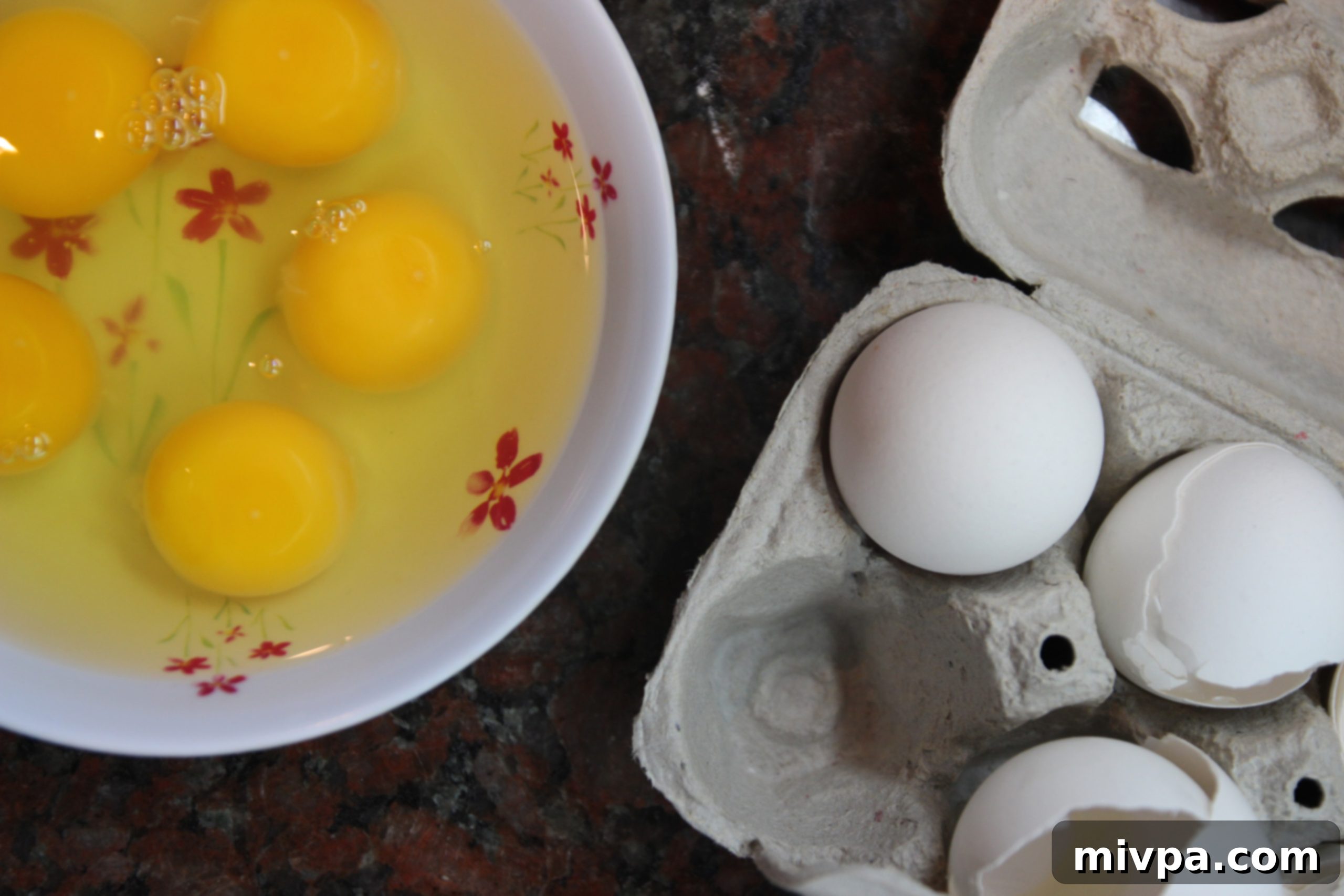
The Rhythmic Dance of Dough Making
Once the ingredients were combined, the real work, and joy, began. I started kneading. My hands plunged into the evolving mass, pushing, folding, stretching, and pressing. It was a rhythmic dance, a meditative process that often accompanies a true passion for cooking. The dough gradually transformed under my touch, becoming smooth, elastic, and homogenous. This tactile connection to the food, the sensation of creating something tangible from raw elements, is profoundly rewarding.
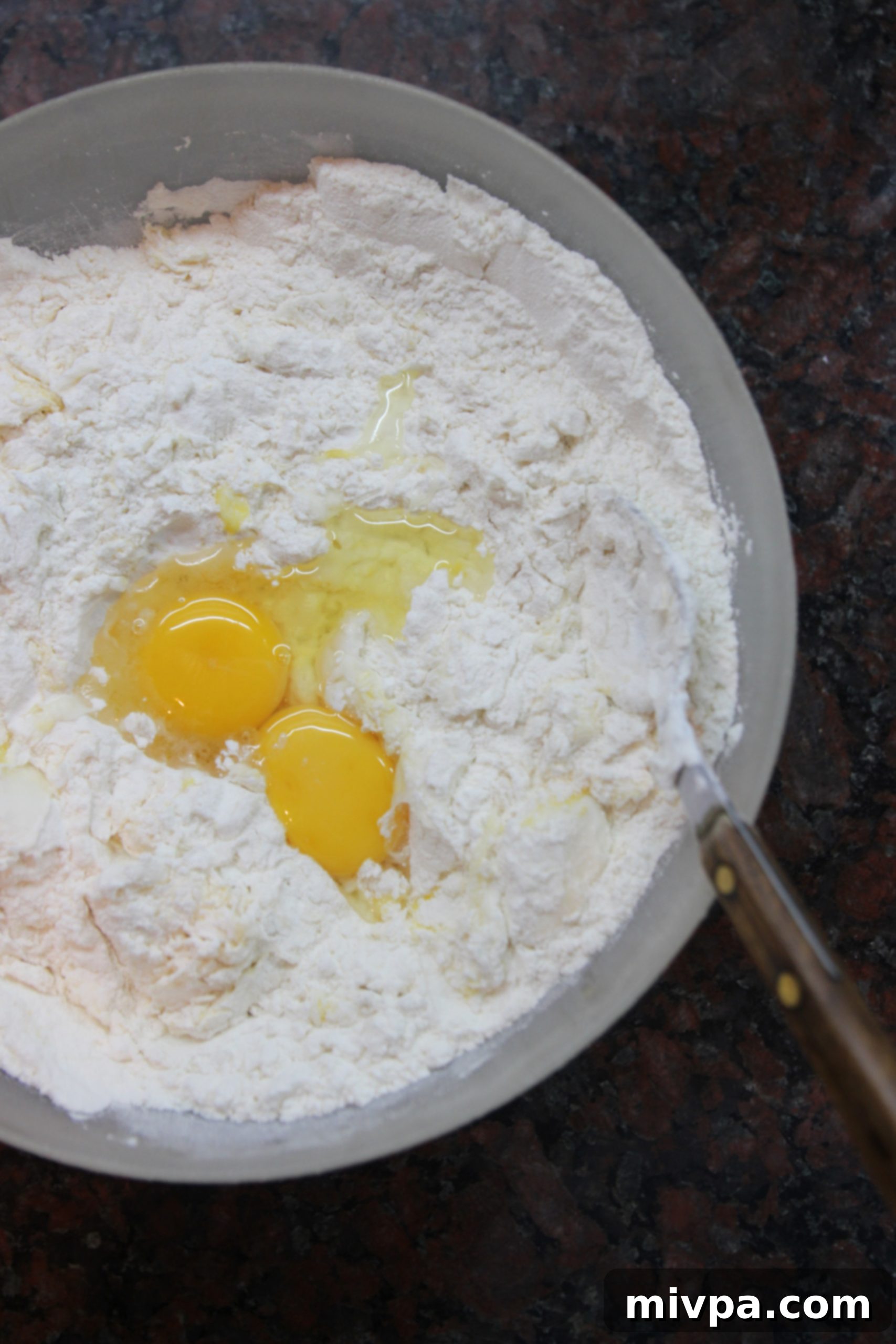
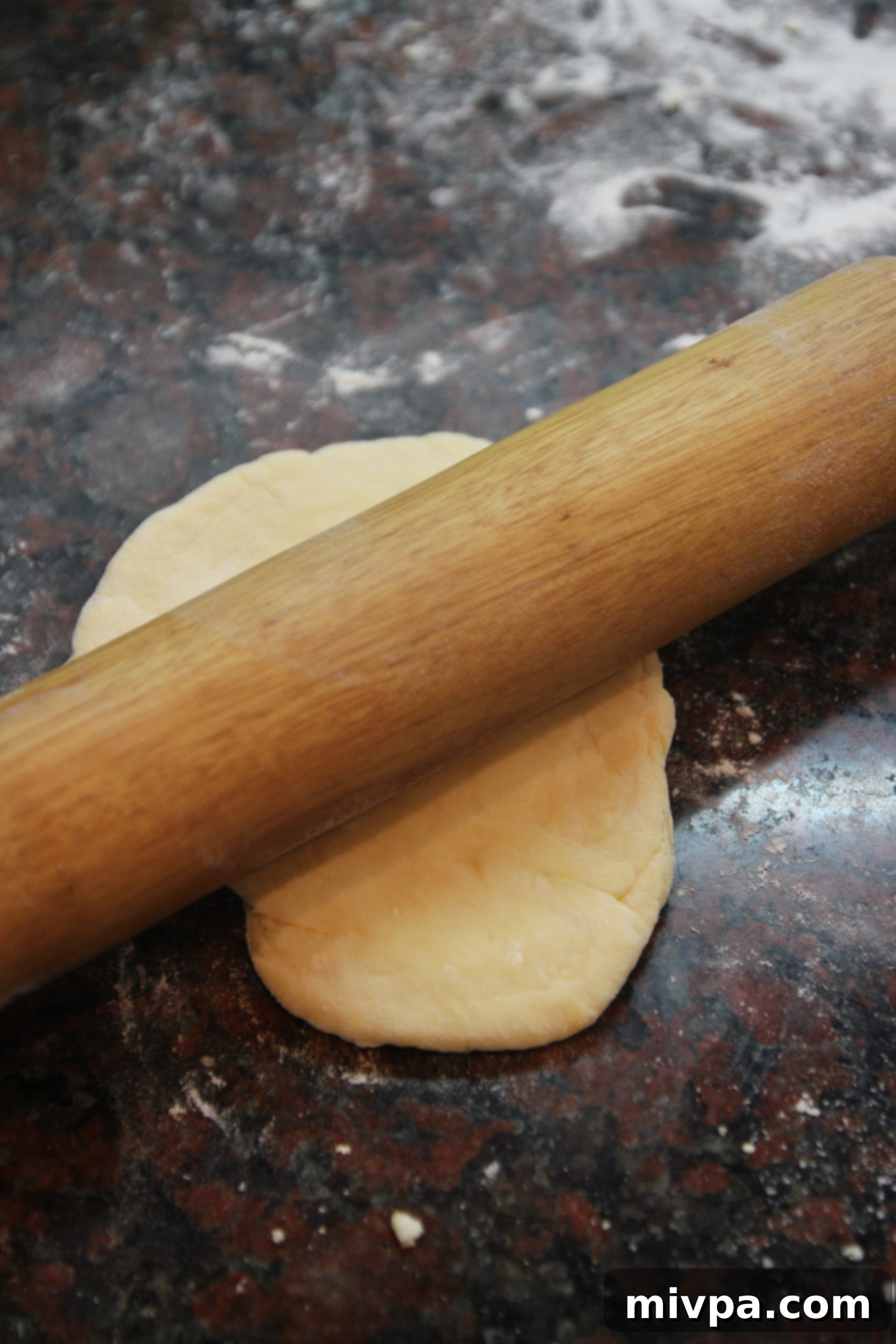
A crucial tip I quickly learned and want to emphasize for anyone attempting this: roll the dough as thinly as humanly possible before feeding it into the machine. And don’t be shy with the flour! A generous dusting is your best friend in preventing the delicate strands of pasta from sticking together, turning your beautiful ribbons into a clumpy mess. This preparation ensures a smooth passage through the pasta maker and perfectly separated noodles.
With the dough rolled into uniform, thin sheets, matching the width of the pasta maker, the moment of truth arrived. Feeding the first sheet through was an act of faith. And then, like a small miracle unfolding before my eyes, delicate shreds of fresh, homemade pasta began to emerge from the other end of the machine. The process was utterly mesmerizing, almost akin to witnessing new life, or hearing the first chirps of birds just as the sun peeks over the horizon, or taking that first deep breath of crisp mountain air. It was pure, unadulterated joy.
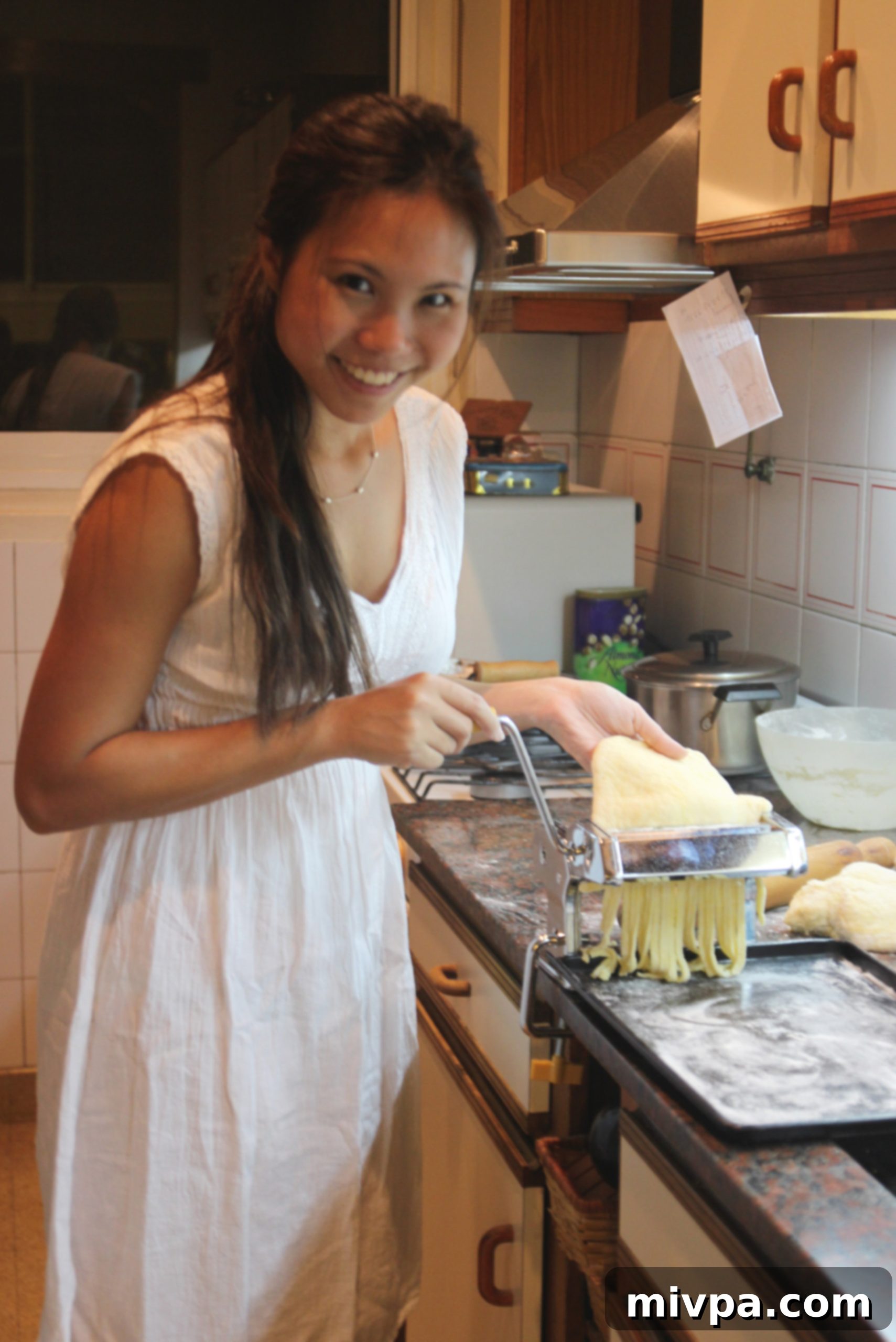
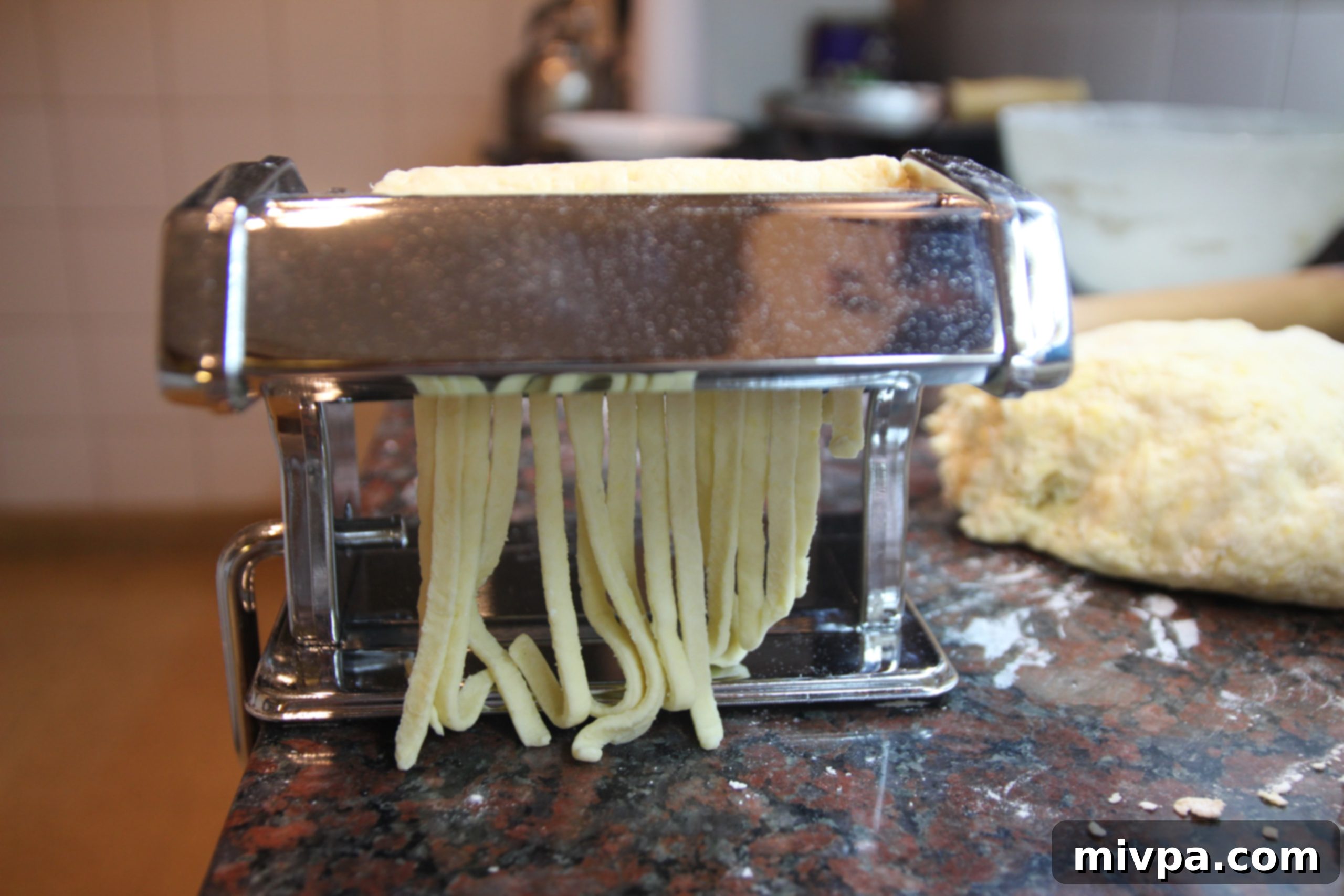
There they were: thick, fresh, soft homemade pasta, still lightly stained with traces of white flour, a testament to their humble origins and my newfound accomplishment. Each strand felt alive, promising a texture and flavor that no store-bought alternative could ever replicate. The tactile sensation of gathering the freshly cut pasta, arranging it on a tray, and knowing that I had created it with my own hands was incredibly satisfying.
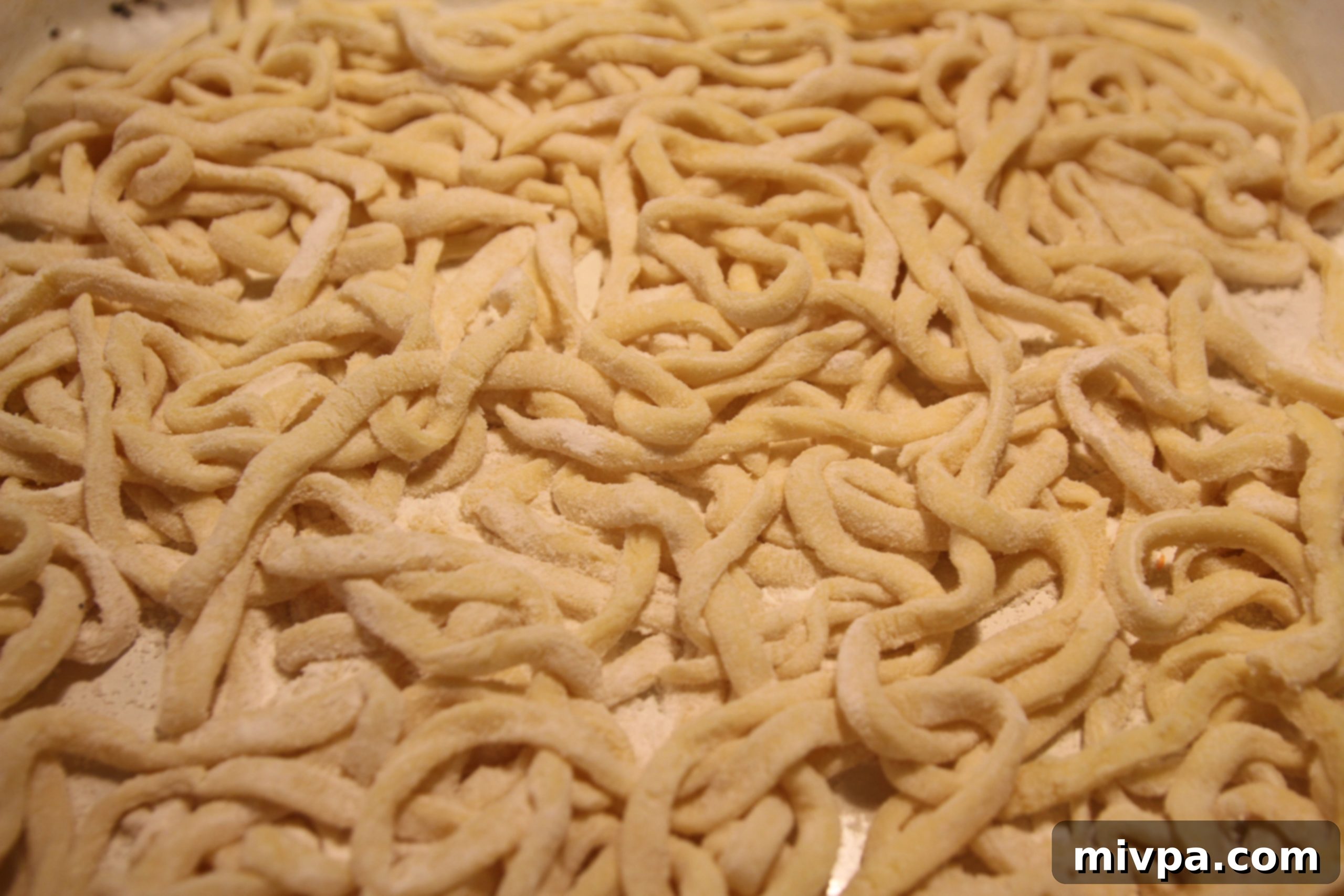
The final step was simple: a quick boil in generously salted water. Fresh pasta cooks much faster than dried, often in just a few minutes. The key is to cook it until it’s al dente – tender but with a slight bite – ensuring it retains its delightful chewiness. Once cooked, these fresh ribbons were ready to be devoured, dressed with any sauce or ingredients my heart desired. The possibilities were endless, and the taste, utterly incomparable.
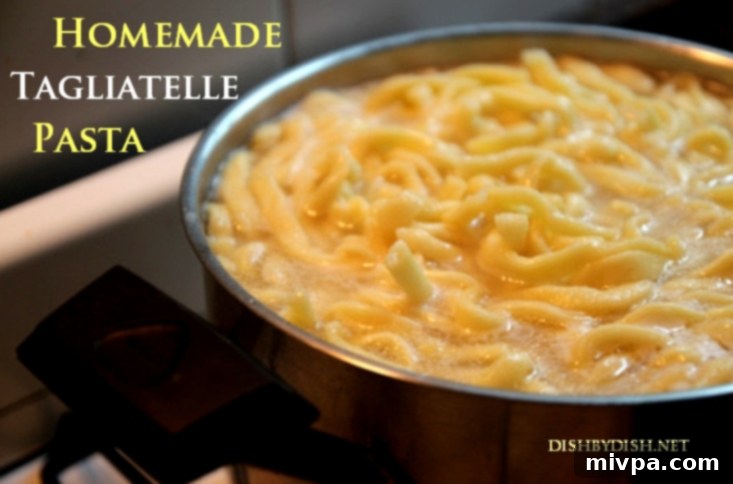
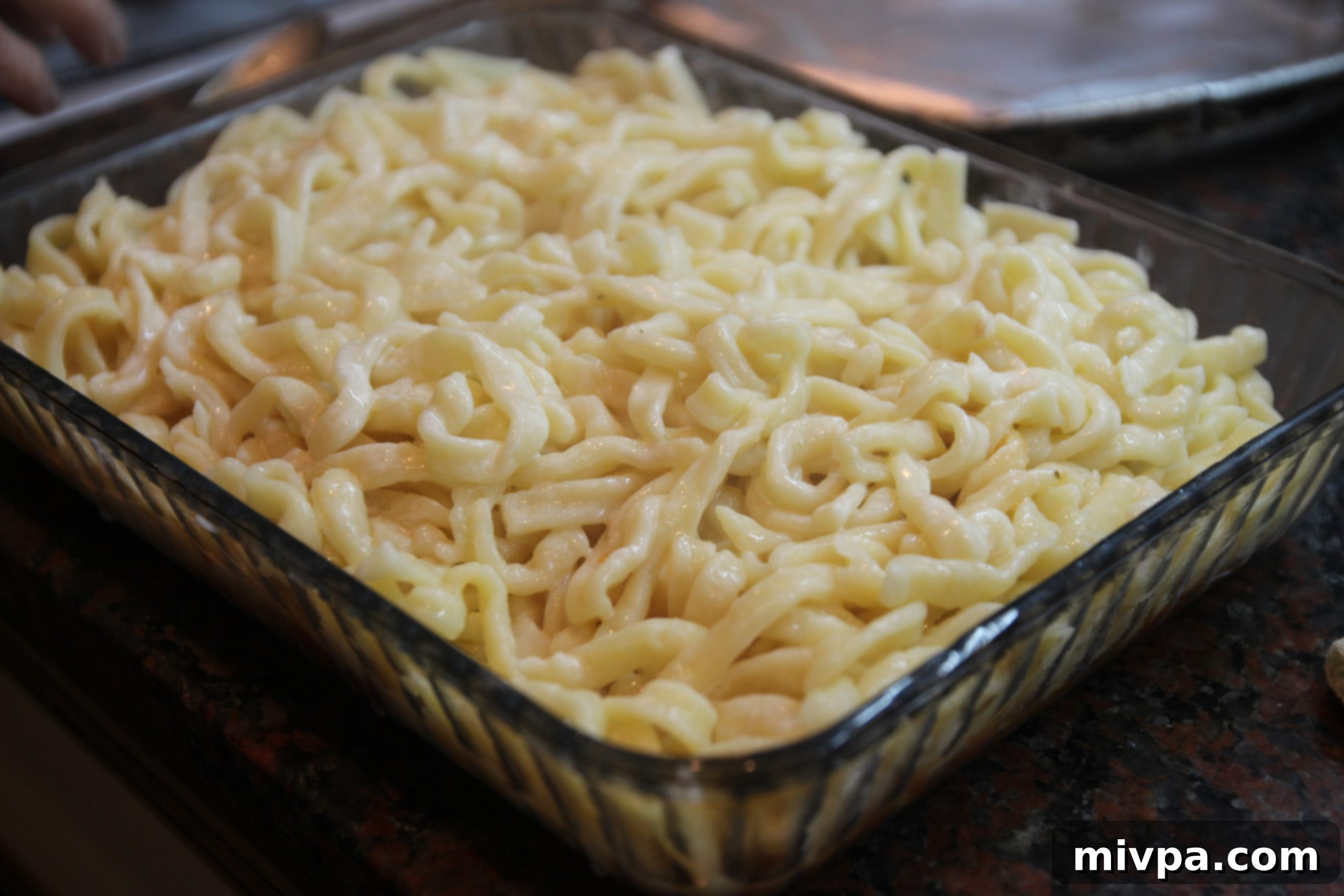
This first venture into homemade pasta was more than just a culinary experiment; it was a journey of overcoming perceived limitations and discovering the immense satisfaction that comes from creating something beautiful and delicious from scratch. If I can do it, so can you. Don’t let the fear of complexity deter you from experiencing the unparalleled joy of fresh, homemade pasta.
Homemade Tagliatelle Pasta Recipe (Serves 8)
Adapted from Claudia’s beloved recipe, this simple yet effective formula yields tender, flavorful pasta perfect for any sauce.
Ingredients:
- 1kg (approximately 8 cups) self-raising flour
- 5 large eggs
- 200ml (approximately ¾ cup) water
- A generous pinch of salt
Steps:
- Combine Ingredients: In a large bowl or directly on a clean work surface, create a well in the center of the flour. Crack the eggs into the well, add the pinch of salt, and gradually incorporate the water. Gently mix the flour and eggs together, drawing flour from the edges into the center. Add water incrementally, just enough to form a cohesive, homogenous dough. If the dough feels too wet and sticky, add a little more flour, a tablespoon at a time, until it reaches a manageable consistency.
- Knead the Dough: Transfer the dough to a lightly floured surface. Knead the dough vigorously for about 10-15 minutes. This develops the gluten, giving the pasta its characteristic chewiness. The dough should become smooth, elastic, and no longer sticky. Once kneaded, cover the dough with plastic wrap or a damp cloth and let it rest for at least 30 minutes at room temperature. This resting period allows the gluten to relax, making the dough easier to roll.
- Prepare for Rolling: Break the rested dough into smaller, more manageable pieces, about the size of a golf ball or a little larger. On a cool, flat, and lightly floured surface, use a rolling pin to flatten each piece of dough as thinly as possible. Aim for a thickness that will easily pass through your pasta machine’s widest setting.
- Flour Generously: Liberally sprinkle each flattened piece of dough with a good quantity of flour. This crucial step prevents the pasta strands from sticking together after being passed through the pasta machine. Don’t be shy – excess flour can always be brushed off later.
- Process with Pasta Machine: Set your pasta machine to its widest setting. Pass each flattened dough piece through the machine. Fold the dough in half or in thirds and pass it through again, repeating this process several times until the dough is smooth and rectangular. Then, gradually adjust the machine to narrower settings, passing the dough through each setting once or twice, until you reach your desired pasta thickness. For tagliatelle, a medium-thin setting is usually ideal.
- Cut the Pasta: Once the dough sheets are rolled to the desired thinness, attach the tagliatelle cutter to your pasta machine. Feed the dough sheets one by one through the cutter. Watch as beautiful, long ribbons of fresh tagliatelle emerge!
- Collect and Dry (Optional): Gently collect all the pasta shreds on a large, lightly floured plate, tray, or even a pasta drying rack. Try to spread them out as much as possible to prevent sticking. If you’re not cooking immediately, you can let them air dry for 30 minutes to an hour, or freeze them for later use (toss lightly with flour before freezing to prevent sticking).
- Cook and Serve: Bring a large pot of generously salted water to a rolling boil. Add the fresh pasta and cook for approximately 2-4 minutes, or until the dough is al dente (tender with a slight bite) and no longer raw. Fresh pasta cooks significantly faster than dried pasta, so keep a close eye on it! Drain well and serve immediately with your favorite sauce.
* Note: If you don’t own a pasta machine, you can still make excellent homemade pasta! After rolling the dough as thinly as possible (Step 3), dust the sheet generously with flour, then gently roll it up into a loose log. Using a sharp knife, carefully slice the log into thin, even shreds. Unroll the tagliatelle strands, dust with more flour, and proceed to Step 5. It takes a bit more time and precision, but the taste will be just as superb.
Visual Guide to Pasta Making:
Mix flour and eggs together to start your dough:
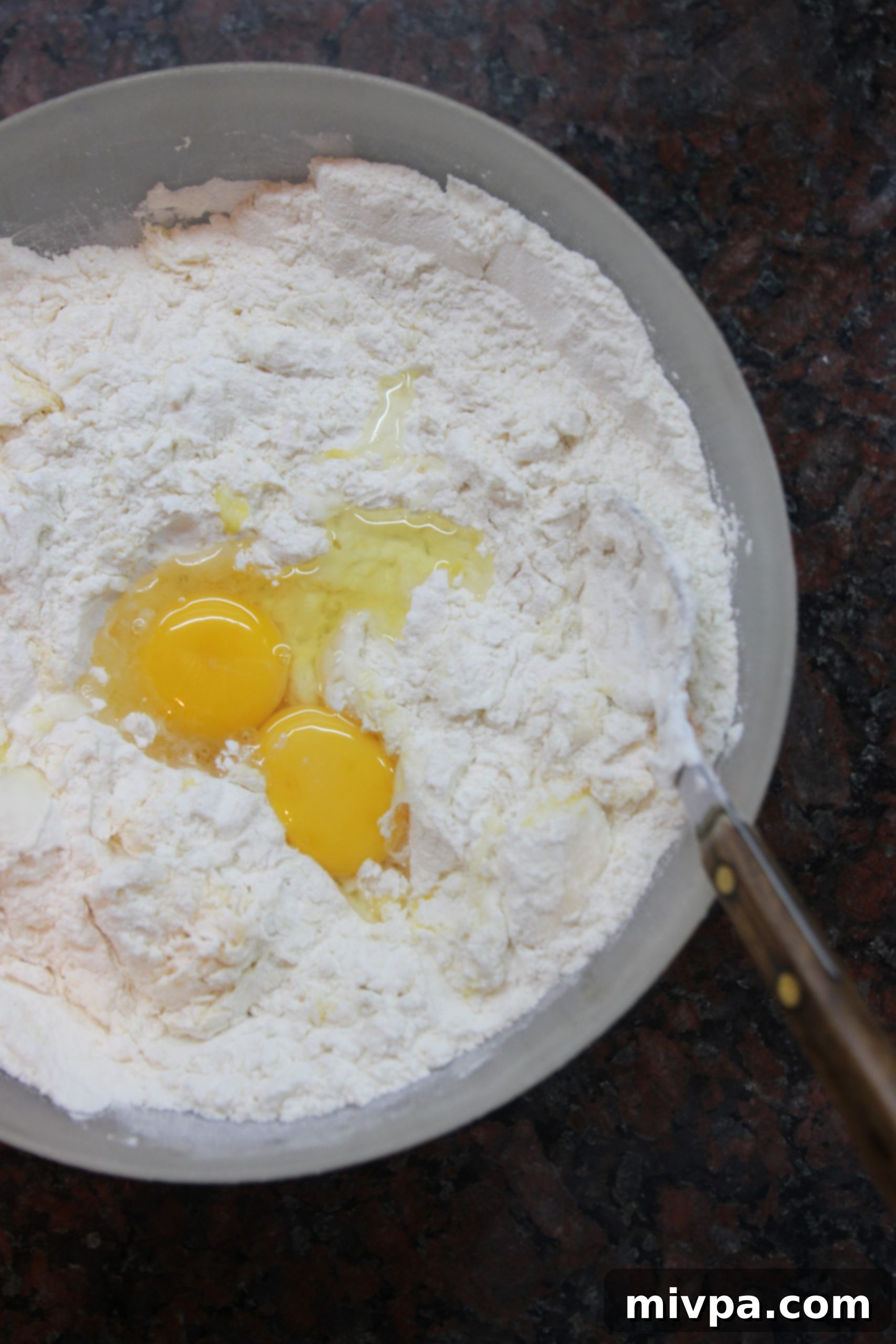
Adding as much water as necessary to form a homogenous dough:
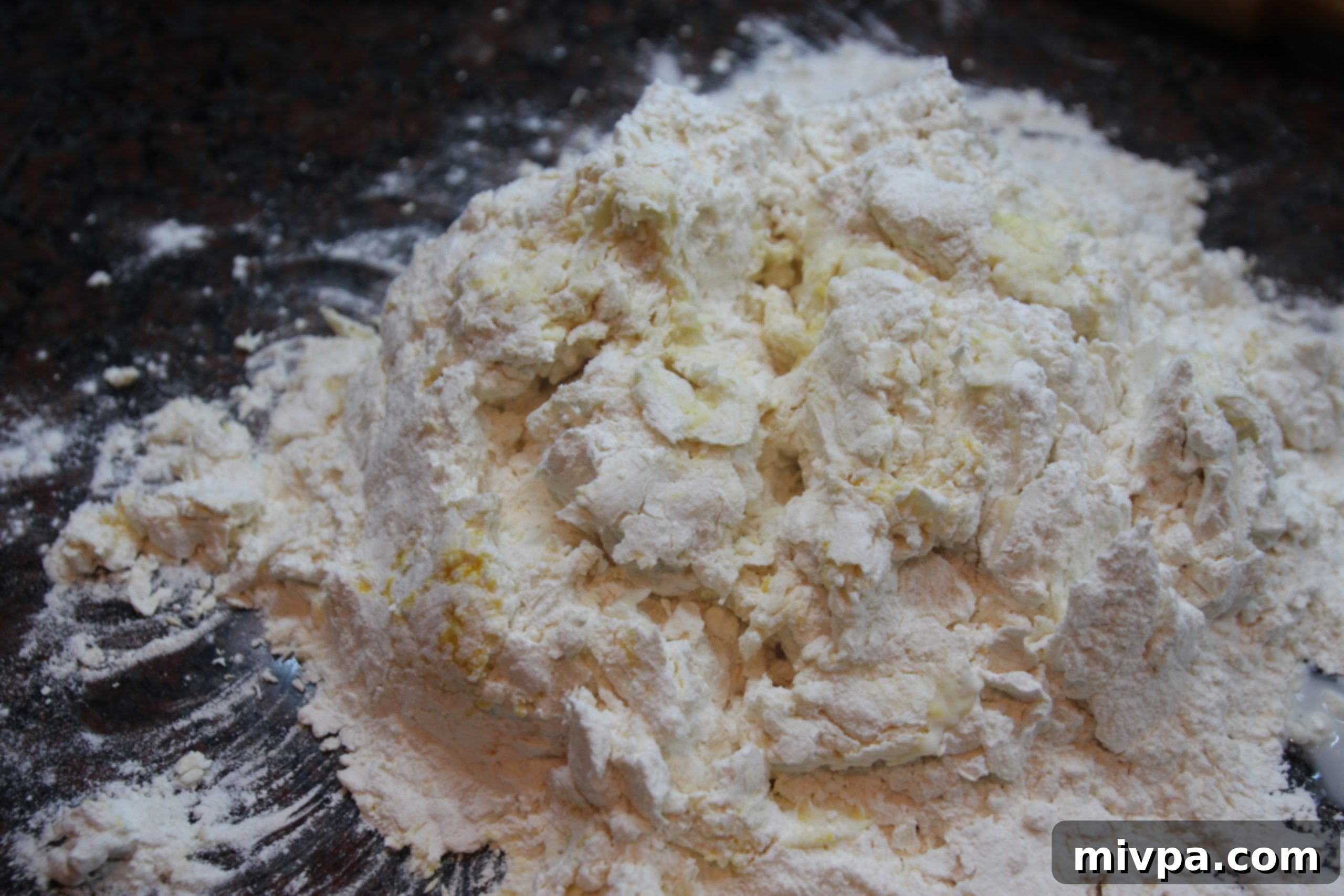
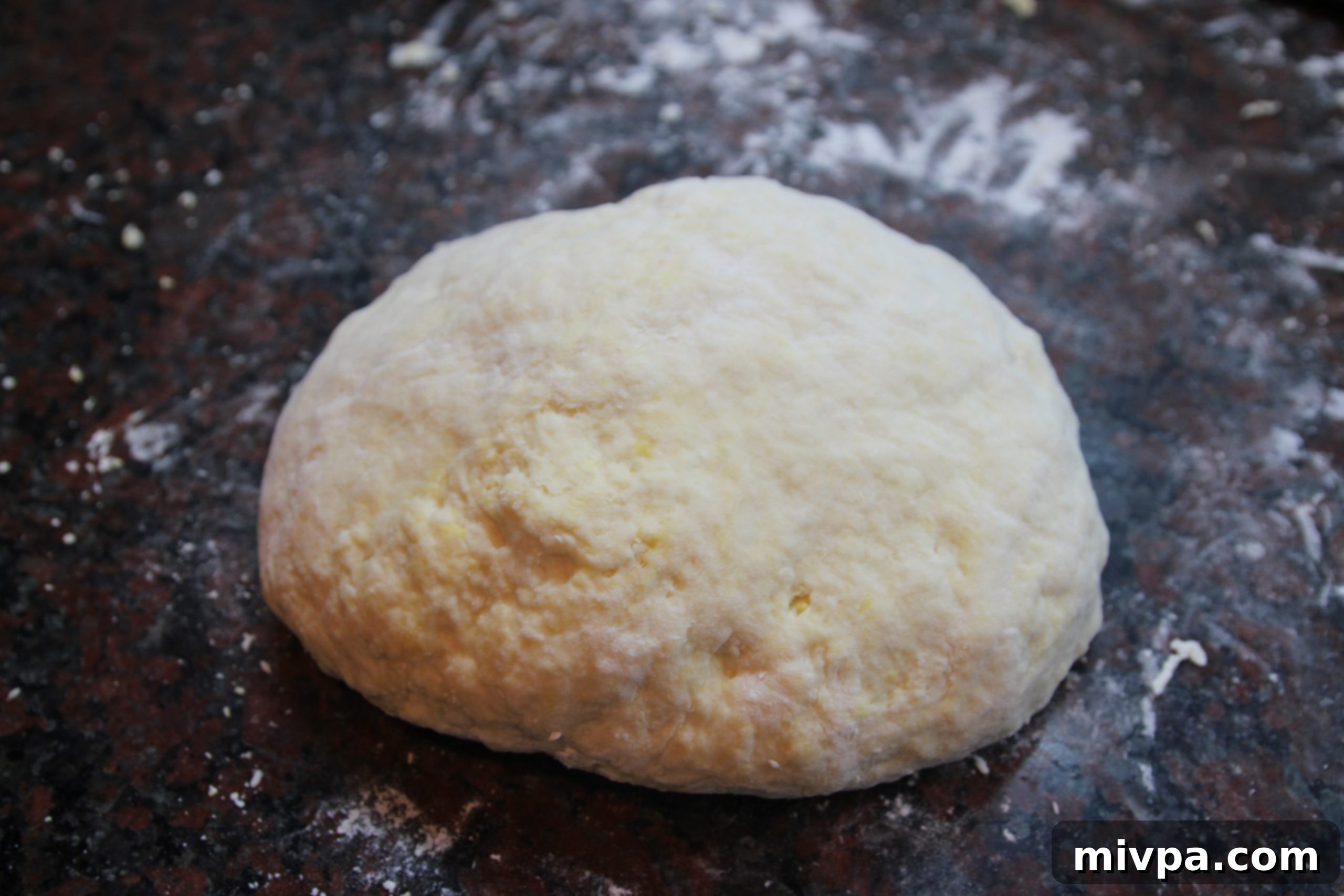
Knead dough well and then break it into small pieces, flattening each piece of dough with a rolling pin on a cool flat surface, as thinly as possible:
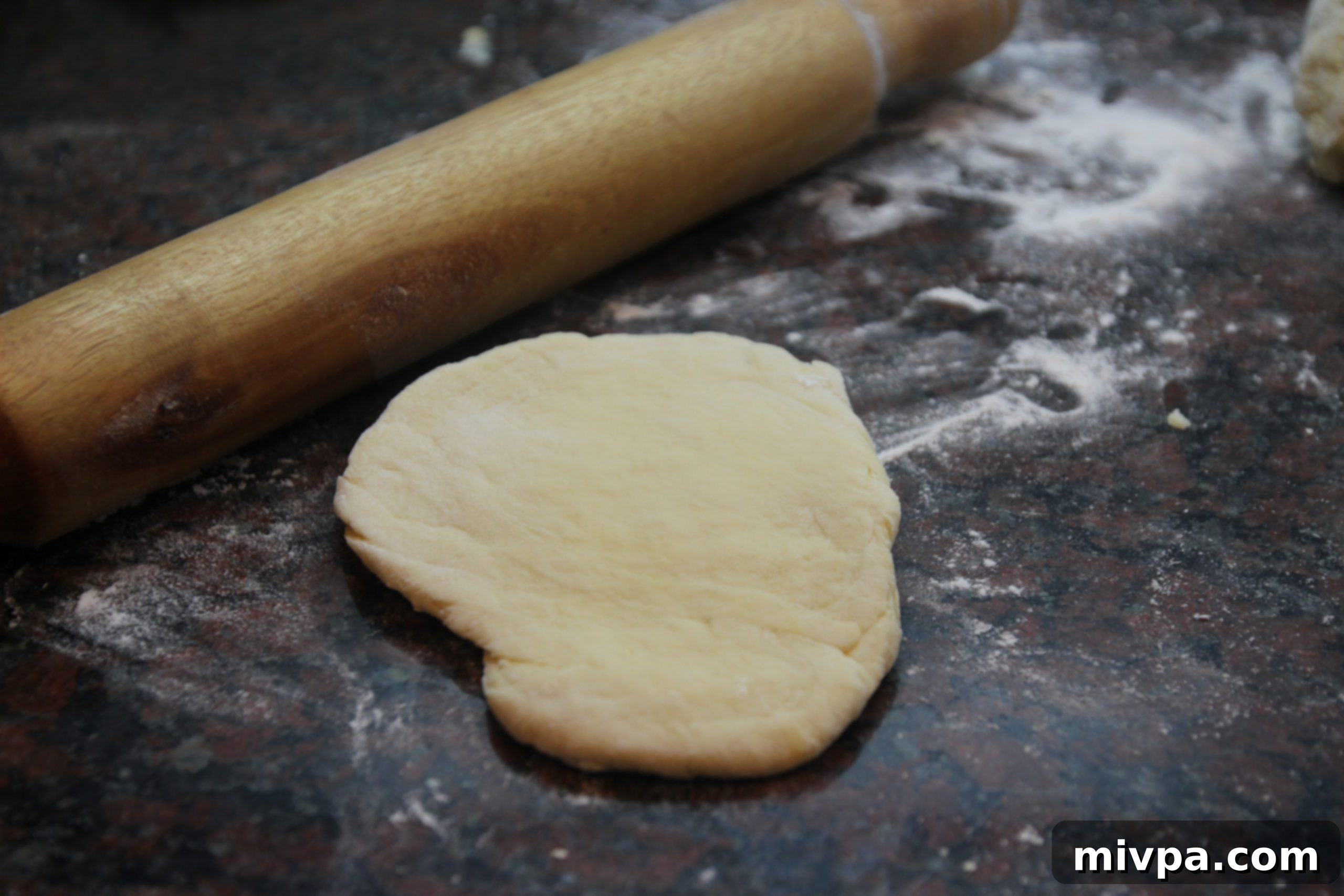
Pass the flattened dough pieces one by one through the pasta machine:
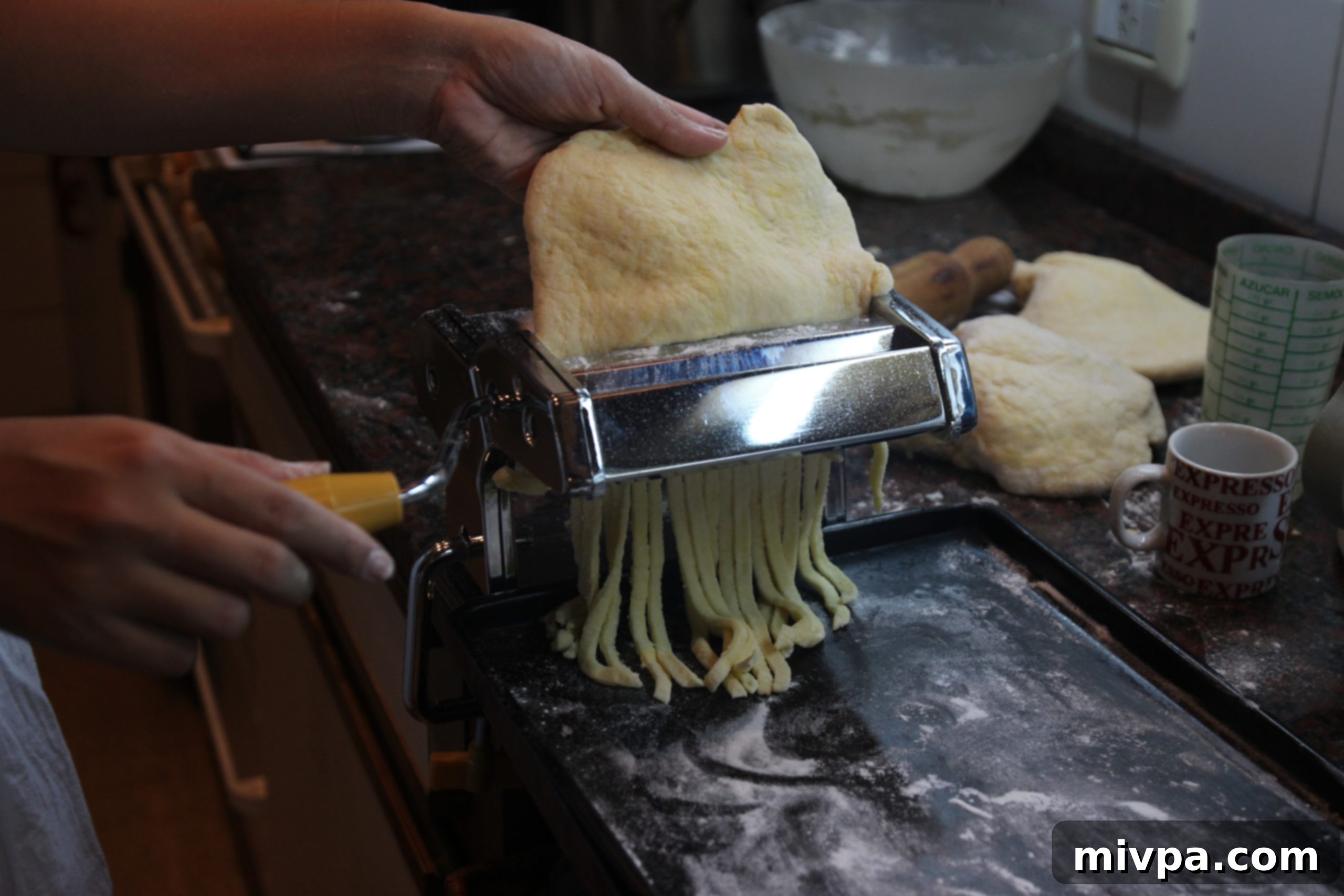
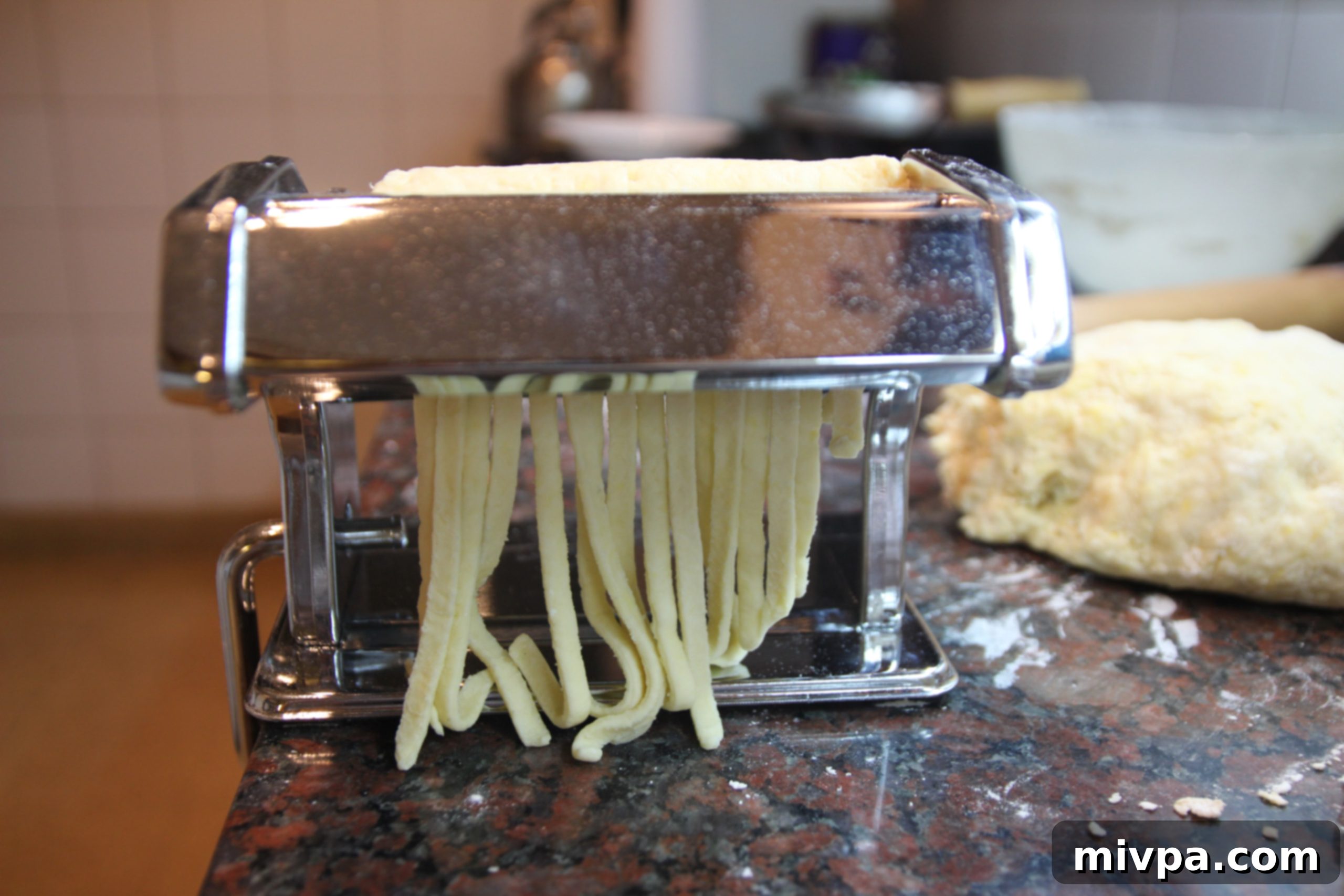
Collect all the pasta shreds in a large plate or tray, trying as much as possible to spread them out:
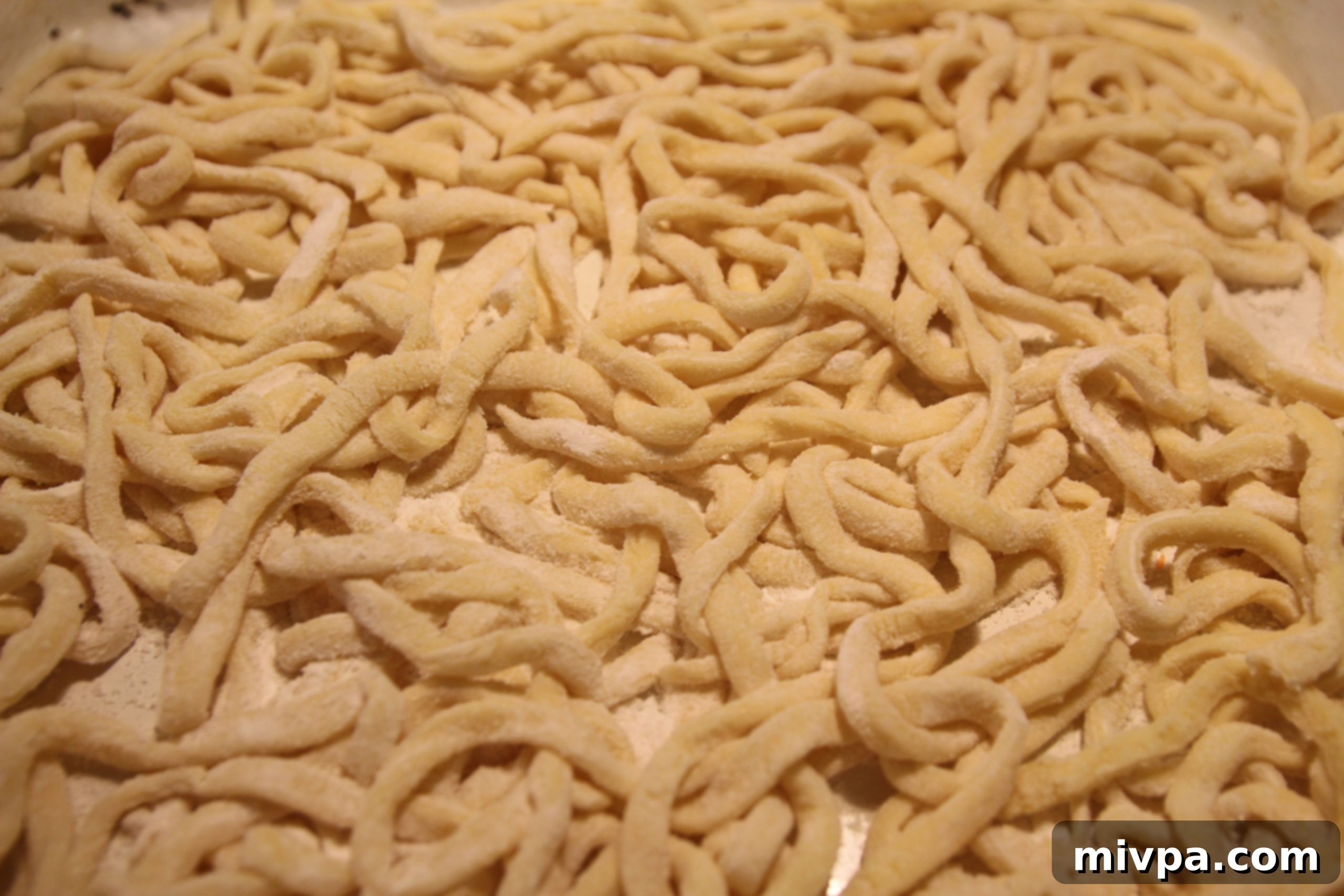
Cook in salted boiling water for about 2-4 minutes or until dough is no longer raw and al dente:
